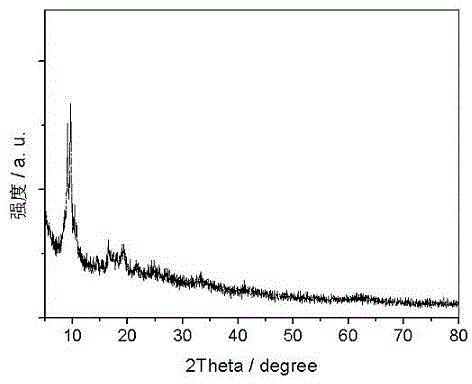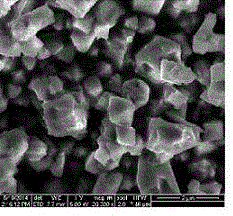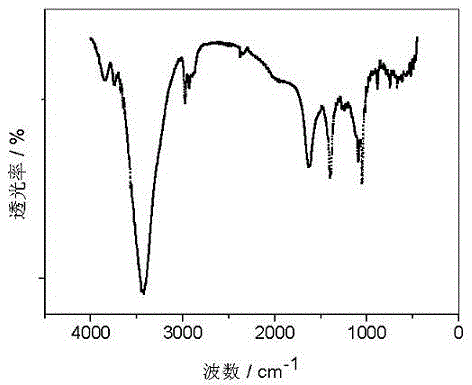Method of treating organic wastewater based on Fenton-like reaction of iron-based organic-framework material
A technology of organic wastewater and metal skeleton materials, applied in chemical instruments and methods, water treatment of special compounds, oxidized water/sewage treatment, etc., can solve the problems of low loading of transition metals, easy loss of metal ions, and improvement of catalytic activity , to achieve the effects of easy access, broad practical application prospects, and easy promotion
- Summary
- Abstract
- Description
- Claims
- Application Information
AI Technical Summary
Problems solved by technology
Method used
Image
Examples
Embodiment 1
[0023] The preparation of catalyst MIL-53 (Fe): with 1.081g FeCl 3 ·6H 2 O and 0.665 g of terephthalic acid were dissolved in 20 mL of N, N-dimethylformamide (DMF), stirred at room temperature for 10 min, mixed evenly, and then packaged in a reaction vessel with a Teflon liner, in React at 150°C for 5h, cool to room temperature; centrifuge, wash with deionized water, pour the obtained tan powder into 200mL deionized water and let it stand for 12h, then centrifuge, and finally vacuum dry at 60°C for 24h. The prepared catalyst MIL-53(Fe) has a specific surface area of 1095m 2 / g, the pore diameter is 0.74nm.
[0024] Degradation of organic wastewater: Prepare 50 mL of rhodamine B dye wastewater with a concentration of 10.0 mg / L, adjust the pH value to 2.3 with HCl or NaOH, add 20 mg MIL-53 (Fe) and 162 mg potassium persulfate as catalyst and oxidant respectively, Stir magnetically at room temperature. After 120 minutes, the degradation rate of Rhodamine B was 91.0%.
Embodiment 2
[0026] The preparation of catalyst MIL-101 (Fe): 0.675g FeCl 3 ·6H 2 O and 0.206 g of terephthalic acid were dissolved in 15 mL of N, N-dimethylformamide (DMF), stirred at room temperature for 10 min, mixed well, and then packaged in a reaction vessel with a Teflon liner, in React at 110°C for 20h, cool to room temperature; centrifuge, then heat-treat in 50ml ethanol at 60°C for 3h, perform a total of two heat-treatments to remove adsorbed impurities, and finally vacuum-dry at 60°C for 24h. The prepared catalyst MIL-101(Fe) has a specific surface area of 3400m 2 / g, the pore size is 1.2 and 1.4nm.
[0027] Degradation of organic wastewater: prepare 50mL of rhodamine B dye wastewater with a concentration of 1.0mg / L, adjust the pH value to 11.0 with HCl or NaOH, add 10.0mg MIL-101(Fe) and 50mg potassium persulfate as catalyst and oxidant respectively , magnetically stirred at room temperature. After 120 minutes, the degradation rate of rhodamine B was 69.7%.
Embodiment 3
[0029] The preparation of catalyst MIL-100 (Fe): with 0.676g FeCl 3 ·6H 2 O and 0.347g of trimesic acid were dissolved in 15mL of deionized water, stirred at room temperature for 10min, mixed evenly, then packaged in a polytetrafluoroethylene-lined reactor, reacted at 160°C for 12h, and cooled to room temperature; After centrifugation, heat treatment in 50ml ethanol at 60°C for 3h, a total of two heat treatments to remove adsorbed impurities, and finally vacuum drying at 60°C for 24h. The specific surface area of the prepared catalyst MIL-100(Fe) is 2210m 2 / g, the pore size is 0.55 and 0.86nm.
[0030] Degradation of organic wastewater: Prepare 50mL of 2,4-dichlorophenol wastewater with a concentration of 10.0mg / L, adjust the pH value to 2.0 with HCl or NaOH, add 50mg MIL-100(Fe) and 125mg potassium hydrogen persulfate to compound Salt as catalyst and oxidant, magnetic stirring at room temperature. After 120 minutes, the degradation rate of 2,4-dichlorophenol was 85.3%. ...
PUM
| Property | Measurement | Unit |
|---|---|---|
| pore size | aaaaa | aaaaa |
| pore size | aaaaa | aaaaa |
| pore size | aaaaa | aaaaa |
Abstract
Description
Claims
Application Information
 Login to View More
Login to View More - R&D
- Intellectual Property
- Life Sciences
- Materials
- Tech Scout
- Unparalleled Data Quality
- Higher Quality Content
- 60% Fewer Hallucinations
Browse by: Latest US Patents, China's latest patents, Technical Efficacy Thesaurus, Application Domain, Technology Topic, Popular Technical Reports.
© 2025 PatSnap. All rights reserved.Legal|Privacy policy|Modern Slavery Act Transparency Statement|Sitemap|About US| Contact US: help@patsnap.com



